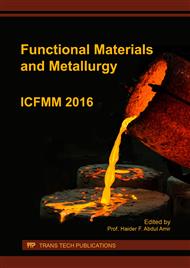p.120
p.125
p.131
p.137
p.142
p.148
p.155
p.160
p.165
Shortwave Triboluminescence of Ce Doped Silicate Phosphor in Sliding Friction and its Potential Application as Light Source Means for Controlling Agricultural Pests
Abstract:
The Ce doped Strontium Magnesium silicate phosphor Sr2MgSi2O7:Ce is compounded by using high temperature roasting process, and the plane sample of prepared phosphor is obtained by tablet press method. A modified MCJ-01A friction tester with the friction pair of glass bar against on the plane phosphor sample is used to determine the triboluminescence property of Ce doped Strontium Magnesium silicate phosphor in the linear contact sliding friction. Examination on the triboluminescence of Ce doped Strontium Magnesium silicate phosphor indicates that a quality triboluminescent phosphor with 448nm± blue spectrum emission can be obtained only in the 1200°C calcining temperature, and only 0.010 molar Ce doping concentration in the Sr2MgSi2O7:Cex can promote the prepared phosphor to generate a higher triboluminecent emission and a smaller full width at half maximum (FWHM). The suitable level of applied load is beneficial to hold a balance between wear increment and spectrum intensity. Finally a triboluminescent unit with squirrel cage structure is constructed to realize the triboluminescence of multiple glass bars against on the cylindrical phosphor in the manner of sliding friction. This can satisfy the light emitting of 360o azimuth, and generate more tribological luminous flux.
Info:
Periodical:
Pages:
142-147
Citation:
Online since:
September 2017
Authors:
Price:
Сopyright:
© 2017 Trans Tech Publications Ltd. All Rights Reserved
Share:
Citation:


